Infiniti Q50 adds AWD to upscale bargain
Filed under: Weekly test drives, Autos
By John Gilbert
The “big three” Japanese automakers have been dominant in the U.S. auto market for several decades, and as good as utilitarian Honda, Toyota and Nissan models have been, all three have upscale brands that have branched off from the mother ships and made their own way to the top.
At Toyota, that would be Lexus; Honda has Acura; and Nissan has Infiniti. In most cases, the companies push their newest technology out to the public in those upscale brands, and in some cases there is no comparison between the top tech of those and the basic stuff. Toyota, for instance, uses Lithium-ion battery packes on Lexus hybrids compared to nickel-metal-hydride on Toyotas; Honda uses new engines in Acuras, and Nissan uses more potent engines and veers away from dependence on only CVTs in its Infinitis.
In the recent economic drop-off, those companies are reeling in some of their more futuristic vehicles, retrenching in the face of the threat of sales dropoffs.
Some of the Infiniti models may lack the promotional punch of the Lexus and Acura vehicles, but at our house, we figure a couple of Infinitis make our all-time favorite list.
A perfect example is the 2021 Infiniti Q50 sedan, which I recently spent a week driving on the North Shore of Lake Superior. The pleasure of driving such a precise and sporty-performing sedan with climate-control blowing air conditioning throughout the cabin, easily outclasses the discomfort of enduring the outrageous 90-degree heat we’ve been feeling most of this sizzling summer.
The particular model we drove was a Signature Edition, which had extra features inside and out, including a couple that are far too significant to have escaped scrutiny in Motor Trend’s annual new-car-capsule edition. Motor Trend’s “experts” seemed to look for all sorts of reasons to put down the Q50 as less worthy than competitive cars, and while claiming the 2021 model is “unchanged” from the 2020 version, overlooked such details as the 300 horsepower or 295 foot-pounds of torque from the 3.0-liter twin-turbocharged V6.
Also overlooked in their snarky evaluation is the fact that the new Signature Edition has Nissan’s “Intelligent” all-wheel-drive system, accessed by a console switch to allow you to direct the power via the 7-speed automatic transmission to all four wheels when you perceive the need. Such an addition, you might think, would elevate the Q50 up to or beyond the competitors in that segment, instead of trailing. And we got over 25 miles per gallon with all that power available, and that was overall, with most of our driving up the hills of Duluth.
But before we blame Motor Trend too much, Nissan/Infiniti itself needs to be called to account in its Monroney sheet of vehicle details for pointing out that the tester’s sticker price of $52,800 includes $695 for “Premium Paint,” but it fails to inform us what the name of that color is. Paint colors are one place where manufacturers can exercise all sorts of cleverly creative hyperbole. But while you can get away with kissing off black or white as, say, black or white, the test car was a stunning dark blue, which sent me scurrying for the sticker sheet to identify the color.
I admit to being a “blue” person, to the point where my wife, Joan, often downplays blue things because she knows I’ll like them too much. But the Q50 Signature was such a riveting dark blue that Joan pointed out to me how much she liked it before I even had the chance to rave about it. It’s so dark that it appears black in subdued light or at nighttime, but when the sun hits it, the dark blue penetrates your senses.
It also makes the bright silver on the aluminum 19-inch wheels an impressive accent, although Joan and I agreed we’d prefer brushed alloy to let the color be even more prominent.

Leather seats and feature-filled interior includes drive-mode and AWD control switches on the console.
In the annual battle to beat the competition out with features, a couple of Nissan’s major achievements have been in accident-avoidance technology, and in the tech-screen display of monitoring anything you might be backing up toward. While others were coming out with impressive rear-view camera views, Nissan was the first I experienced with full 360-degree surround video in some Infinitis, which showed the ability to scrutinize anything within several feet of your road space in all directions.
On the new Q50, if you hit the right setting you get a top-down perspective of your vehicle with a moat around it, preferably free of any objects. And in their best simplicity, Infiniti calls the system “AroundView Monitor with Moving Object Detection.” That view is in addition to the car’s innate ability for automatic collision notification, predictive forward collision warning, blind-spot warning, lane-departure warning and back-up collision intervention.
All that stuff is standard on the $50,000 Signature version, as is the hill-start assist, adaptive cruise control with distance-control assist, and active trace assist, which can use all those electronic features to keep you in your lane around curves. Naturally, with all those ingredients, linking up with your smart phone is a given, as is the navigation system.
Going back to Nissan’s early sports-car days, with the 240Z and since then, the company has put a premium on sporty and precise handling, and the Q50 snakes around curves as if on those sports-car rails, making it enjoyable to drive and also comfortable both in the passenger and rear seat. A switch on the console lets you pick standard, eco, sport, personal, or snow/ice, for handling or traction needs.
All of those seating surfaces were covered a rich and soft leather.
Also, all the driving enjoyment was amplified — literally — by the Bose 15-speaker audio system, which filled the interior with sounds of your choosing. In fact, so good was the audio system that we spent seven solid days of driving the car before, on the final morning, discovering a neat little horizontal trim line near the audio controls; it was not a trim line, but a CD player! I love CD players, which almost all new cars don’t bother installing any more, I give added gold stars to any that do, because all of us, right up to the biggest MP3 addicts, have shelves or drawers full of CDs, and you would love to be able to play them while on the road.
Maybe if the Q50 had fewer gadgets and features, I might have noticed the CD slot a lot sooner, but I’m going to blame Infiniti for not boasting about it more or at least pointing it out.
If that is the ultimate nitpick, I have one more complaint in such a near-perfect car. OK, two other complaints. One is that the heated seats lacked the more-recent trend of having perforated leather that allows cooled air to circulate and keep you infinitely cooler on hot days. My car doesn’t have them either, but I’ve appreciated them on many of the vehicles I’ve driven since Climate Change decided to fry us all, and I’m sure you could probably find them on the option list for the Q50. But if I’m calling this one of the best near-premium, sports-luxury sedans for the bargain price of $52,800, then cool off my backside, OK?,
My other suggestion is that the Q50’s 7-speed automatic is smooth-shifting and precise, but it lacks steering-wheel paddles, which, with such tremendously responsive power, would be an ideal feature. Maybe they were left behind because the steering wheel already is loaded up with remote controls, but they would advance the pleasure of accelerating or decelerating — especially on hills, where downshifting is the best brake preservative on the planet.
Maybe such things are available for a few more bucks, but those two features are significant enough that one of them would add to the luxury image and the other to the sporty image. Maybe they wanted to see if Motor Trend would notice.
Ascend lets Subaru ascend to big SUV realm
Filed under: Weekly test drives, Autos
By John Gilbert
When Subaru made assorted small all-wheel-drive vehicles and everybody else made big ones, it seemed as though both sides competed with each other in lifestyle as well as vehicle choice. It was sort of like two knights in shining armor pulled their facemasks down, straightened their armor, lowered their lances, and charged! And both sides scored direct hits.
The companies making large, overpowered SUVs have downsized successfully, with a smaller model, or two, or six — while Subaru keeps trying to enlarge some models into bigger SUVs.
It may be that Subaru will never match the Suburban or Expedition or Land Cruiser, and surely it doesn’t want to. But Subarus keep growing, like the new Forester, and now, entering its second season for 2021, Subaru was its own large SUV, with the Ascent.
Interesting name, and obviously it is hoping to conjure up the name of something that will climb the highest mountain, or at least the steepest terrain — or the tallest avenues in a Duluth blizzard — without difficulty.
Presumably, if Subaru sells enough Ascents, it might bring out something still larger, and call it, maybe, the Descent, if it’s decent, because we all know that what goes up must come down, hopefully with style and grace in the process.
The Ascent ranges in price from $35,000 to around $45,000, depending on how many added options you choose. But it does rise above the normal tradition of bargain-priced and compact-sized Subarus.
Subaru fans are amazingly loyal. They love the ruggedness, the dependability, the all-weather hardiness, the all-terrain capability, and if they never push their Subarus to the limits, they like the security of having those capabilities in reserve.
I guess of all the Subarus, my favorite three remain the WRX STi, which is an all-terrain race and rally hot-rod, the Crosstrek, a very tidy compact SUV that leads the company in style, in my opinion, and the now-extinct SVX, which was the sleekest and raciest Subaru ever but was discontinued in 1997. That was my all-time favorite, and I still see one around Duluth occasionally by an appreciative owner.
All Subaru lovers accept the odd, flat-opposed four and six cylinder engines that deliver good power but not great fuel-economy, and we can only wonder where that aging engine will fit if and when Subaru follows the leaders toward electric vehicle power. Or even advanced plug-in hybrids.
For now, we needn’t worry about all that. We have good-size vehicles like the Outback and Forester, and now we have the biggest Subaru with the Ascent, one that’s capable of hauling a family of seven or eight on its appointed rounds, or even off the beaten and appointed rounds.
After spending a week with an Ascent “X” — the sportiest version — we ran it through its paces. We used it for commuting, for running errands, and for cruising, as we ventured off on an assortment of short trips to destinations that took awhile. Our favorite was to drive from Duluth, up the North Shore to Grand Marais, which is quite nearer the Canadian border, and a very neat and trendy little artsy community with a scenic pleasure-boat harbor.
We even found a new place to eat up there, although it took awhile because road construction has found its way into the Lake Superior harbor area of downtown Grand Marais. We circled around to get downtown to check out a couple of outfitter’s stores, and we followed a similar route to get back to the west side and out of town. Then we circled back around to get to the eastern edge of Grand Marais, where our built-in GPS told us we would find a restaurant called My Sister’s Place. We had never visited it before and it has a surprisingly large menu and, we found, very good food that bridges the gap from comfort food to the more gourmet-type offerings. We need to go back to verify our first finding.
That gave us a target beyond the Angry Trout, and Sven and Ole’s Pizza, where you pretty much are drawn in by the name alone and lured back because it’s not only good pizza, but you get a large yellow sticker with blue script lettering to tell the world that you’ve been to Sven and Ole’s. Good to know that Swedes and Norwegians like pizza, too.
My personal favorite stopping place is right near the outfitters store, hard by the harbor. In past columns I have mentioned how that place reminds me of the Jimmy Buffett song, “One Particular Harbor,” and it still does. This time was extra special, because after wandering around town, I heard the faint strains of an Eagles song, being sung outdoors. Following my ears, we walked over toward the water where there was a small stage set up and a fellow was playing the guitar and singing an assortment of Bob Dylan songs, interspersed with a few Gordon Lightfoot ballads. He had a couple of guys backing him up, and he was highly entertaining, both in his choice of songs and in his professional-quality delivery.
I walked up after they took a break and learned his name was Joe Paulik, and he said he plays up there on the beach every Saturday night, only venturing down as far as Duluth on rare occasions. I have mentioned him to a couple of Duluth promoters, who would do well to expand on what has become an all-too-familiar array of performers. I would pay a cover charge to go see Joe, and he would do well at one of the assorted “fests” at Bayfront Festival Park.
Anyway, we also had a good time driving up the Shore and back in the Ascent, stopping along any of dozens of favorite spots such as Iona’s Beach along the big lake, which is always a treat, even if it’s no particular harbor.
The 2.4-liter 4 handled all of our demands of the Ascent with ease, and while performance was adequate, comfort was at a high. I particularly liked the seat surface, which is some sort of new material that is a cut above the usual fake-leather-but-really-vinyl, and is not unpleasant to touch, and feels as though it might be bullet-proof for kids or pets. The material is repeated on the dashboard, which gives the interior of the Ascent a boost as well.
The size of the Ascent is big for a Subaru, but would be compact for other companies, although the key determination in my mind is the availability of a third row of seats. The Ascent has a third row, and it’s reachable by a second row that folds down and slides fore and aft, to ease the entry and exit to Row 3. Let’s face it, though, that third row is for small kids, and especially those who feel gymnastic urges after watching the Olympics.
We got about 24.4 miles per gallon as a normal, everyday average for fuel economy, and the Ascent drinks regular fuel, which is nice, because you are saving 20 or 30 cents per gallon over premium alternatives.
The interior has a sporty flair, something Subaru hasn’t always put on display. The colors and fabrics and trim levels were a step up — Ascending, we might say — over the Subaru norm. All of the connectivity and contemporary features are in place, and I like the thick feel of the steering wheel. Carbon-fiber trim on the dash and doors was a nice touch, too.
While the power was good enough, I was surprised that the handling was just so-so. It felt a little loose, for some reason, and it should have been firmer, based on the sporty styling, and the large wheels, which were shod with 245-45, 20-inch tires.
The big information screen was impressive, also, but there was almost too much. We wanted to find the exterior temperature, for example, because that’s important in this summer of 90-ish highs complemented by Canadian wildfire smoke channeled directly to us, but we couldn’t locate the temp gauge. After scrutinizing the instruments over and over, we finally spotted it, located in its own, separate binnacle up on top of the dashboard by the windshield. We almost needed a GPS to find it.
A definite sporty touch is the presence of steering wheel paddles, which give you the ability to instantly choose if you want a higher or lower gear range, which is particularly helpful if you are descending Duluth’s long and hilly avenues, where it might spend its brakes prematurely if you were to ride the brakes down those hills every day.
There you are, another reason that the Ascent with paddles should next be joined by a Descent model.



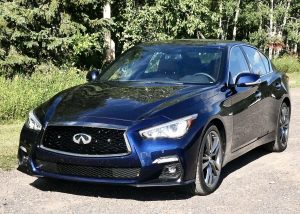
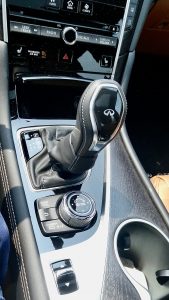
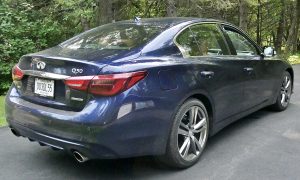
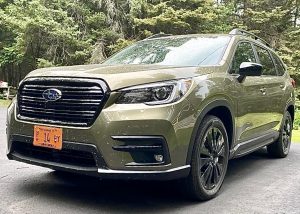
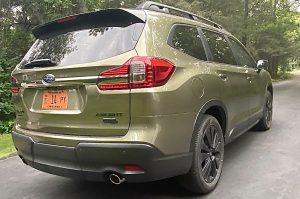
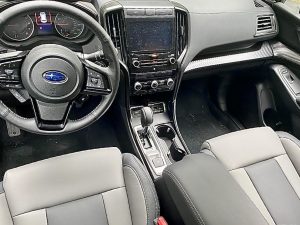
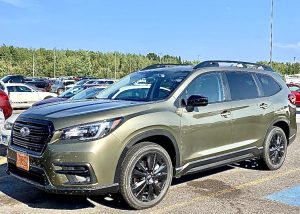
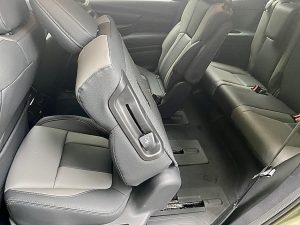
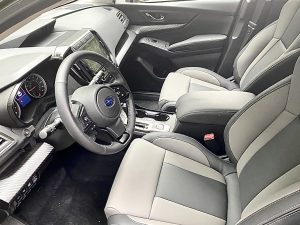
 John Gilbert is a lifetime Minnesotan and career journalist, specializing in cars and sports during and since spending 30 years at the Minneapolis Tribune, now the Star Tribune. More recently, he has continued translating the high-tech world of autos and sharing his passionate insights as a freelance writer/photographer/broadcaster. A member of the prestigious North American Car and Truck of the Year jury since 1993. John can be heard Monday-Friday from 9-11am on 610 KDAL(www.kdal610.com) on the "John Gilbert Show," and writes a column in the Duluth Reader.
John Gilbert is a lifetime Minnesotan and career journalist, specializing in cars and sports during and since spending 30 years at the Minneapolis Tribune, now the Star Tribune. More recently, he has continued translating the high-tech world of autos and sharing his passionate insights as a freelance writer/photographer/broadcaster. A member of the prestigious North American Car and Truck of the Year jury since 1993. John can be heard Monday-Friday from 9-11am on 610 KDAL(www.kdal610.com) on the "John Gilbert Show," and writes a column in the Duluth Reader.